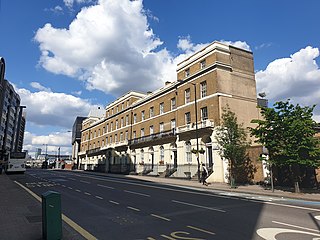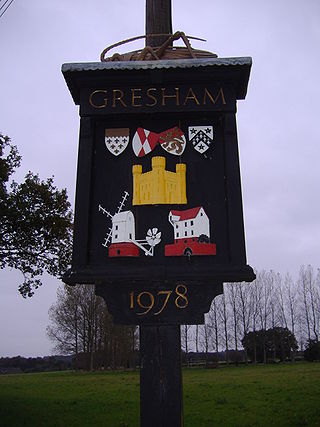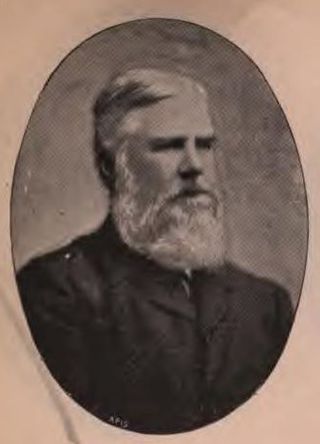
Carmarthen is the county town of Carmarthenshire and a community in Wales, lying on the River Towy 8 miles (13 km) north of its estuary in Carmarthen Bay. The population was 14,185 in 2011, down from 15,854 in 2001, but gauged at 16,285 in 2019. It has a claim to be the oldest town in Wales – Old Carmarthen and New Carmarthen became one borough in 1546. It was the most populous borough in Wales in the 16th–18th centuries, described by William Camden as "chief citie of the country". Growth stagnated by the mid-19th century as new settlements developed in the South Wales Coalfield.

Sir Thomas Erpingham was an English soldier and administrator who loyally served three generations of the House of Lancaster, including Henry IV and Henry V, and whose military career spanned four decades. After the Lancastrian usurpation of the English throne in 1399, his career in their service was transformed as he rose to national prominence, and through his access to royal patronage he acquired great wealth and influence.

Anchor Terrace is a large symmetrical building on the east side of Southwark Bridge Road in London, situated very close to the River Thames. It was built in 1834, and its original inhabitants were senior employees of the nearby Anchor Brewery, Southwark, which was then owned by Barclay Perkins & Co. Ltd. The building was later used as the brewery's offices. It overlooks the site of the former brewery and is next to the headquarters of the Financial Times.
Frederick Spurrell was an Anglican priest and archaeologist.

Horsham St Faith is a village in Norfolk, England. The village lies close and to the east of the A140 road and is 5 miles (8.0 km) north of Norwich and some 8 miles (12.9 km) south of Aylsham It takes its name from the River Hor, which runs through it on its way from Horsford to Horstead; and a Benedictine priory, founded in honour of St Faith that, until the dissolution of the monasteries, stood there. It is near Norwich International Airport, which began in 1939 as RAF Horsham St Faith and home of the City of Norwich Aviation Museum. Administratively it is in the civil parish of Horsham St Faith and Newton St Faith within the district of Broadland. It also forms part the wider Norwich Built-up area.

Erpingham is a village and civil parish in the English county of Norfolk. The village is located 3.1 miles (5.0 km) north of Aylsham and 15 miles (24 km) north of Norwich, along the Scarrow Beck. In 1935, Erpingham parish was merged with Calthorpe to form the parish of Erpingham with Calthorpe.

Flaxman Charles John Spurrell was a British archaeologist, geologist and photographer who worked mainly in Kent and East Anglia. He was also a noted egyptologist, working closely with Flinders Petrie.

Thurgarton is a village and former civil parish, now in the parish of Aldborough and Thurgarton, in the North Norfolk district of the county of Norfolk, England. It lies 6½ miles north of Aylsham and 5½ miles south-west of Cromer, and was once part of the North Erpingham hundred. In 1931 the parish had a population of 186.

Bessingham is a village and former civil parish, now in the parish of Sustead, in the North Norfolk district of the English county of Norfolk. It lies 8 mi (13 km) north-north-west of Aylsham and 5 mi (8.0 km) south-south-west of Cromer. In 1931 the parish had a population of 122. On 1 April 1935 the parish was abolished and merged with Sustead.
James Shears and Sons was a firm of London coppersmiths and braziers who were active from c1785 to 1891. The firm was founded by James Shears (c1750-1820) and continued by his two sons Daniel Towers Shears (1782–1860) and James Henry Shears (1788–1855) and subsequently by William Shears.

Gresham is a village and civil parish in North Norfolk, England, five miles (8 km) south-west of Cromer.

Sidestrand is a village and a civil parish on the coast of the English county of Norfolk. The village is 23.7 mi (38.1 km) north of Norwich, 3.3 mi (5.3 km) south east of Cromer and 138 mi (222 km) north-east of London. The nearest railway station is at North Walsham for the Bittern Line which runs between Cromer and Norwich. The nearest airport is Norwich International Airport. From the Census 2011 the population was included in the civil parish of Trimingham.

William Phelip, 6th Baron Bardolf, KG, was an English landowner, soldier, politician, and administrator from Dennington in Suffolk.

Horsham St Faith and Newton St Faith is a civil parish in the English county of Norfolk, consisting of the former parishes of Horsham St Faith and Newton St Faith. Collectively they are known as St Faiths. It covers an area of 7.33 km2 (2.83 sq mi) and had a population of 1,624 in 770 households at the 2001 census, increasing to a population of 1,724 in 797 households at the 2011 Census. For the purposes of local government, it falls within the district of Broadland.
The name Rhyd-y-gors or Rhydygors has been associated with two historic sites near the market town of Carmarthen in Southwest Wales. The first was the Norman Rhyd-y-gors Castle and the other was Rhyd-y-gors Mansion, home of the Edwardes family.

Sir Samuel Hoare, 1st Baronet, was an English Conservative Party politician who sat in the House of Commons from 1886 to 1906.
High Elms Manor is a grade II listed Georgian country house located near Garston in Hertfordshire, England. It was built in around 1812, and was originally known as "High Elms", but from the 1890s to 2010 it was called Garston Manor.

Calthorpe is a small village and former civil parish, now in the parish of Erpingham, in the North Norfolk district, in the county of Norfolk, England. The village is located 0.5 miles (0.80 km) west of the village of Erpingham, 3.4 miles (5.5 km) north of the nearest town of Aylsham and is 15.8 miles (25.4 km) north of the nearest city of Norwich. The nearest railway station is at Gunton for the Bittern Line which runs between Sheringham, Cromer and Norwich and is 7.8 miles (12.6 km) from the village. The nearest airport is Norwich International 14.2 miles (22.9 km) south of the village. In 1931 the parish had a population of 143.
William Spurrell was a printer and Welsh publisher, whose name is associated with one of the most popular Welsh language dictionaries, the Spurrell's Welsh Dictionary English-Welsh.
















